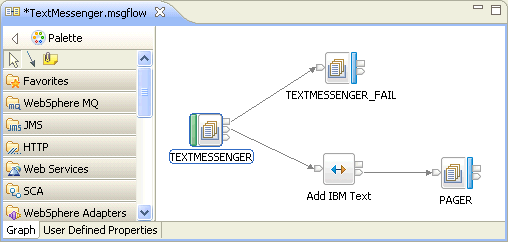When you open a file for editing, for example by double-clicking it in the Application Development view, the default editor associated with that file opens in the editor area of the current perspective. By default, the editor area is in the upper-right corner of the IBM Integration Toolkit window.
Open resources with the default editor because other editors might not validate the changes correctly.
The following diagram shows the TextMessenger.msgflow file from the Pager sample opened in the Message Flow editor, which is part of the Integration Development perspective.

You can open any number of editors at the same time, but only one editor is active at a time. The main menu bar and main toolbar display the operations that apply to the active editor. By default, editors are stacked in the editor area, but you can tile them to view source files simultaneously. Tabs in the editor area indicate the names of the resources that are open for editing. An asterisk (*) indicates that an editor has unsaved changes. If you attempt to close the editor or exit the IBM Integration Toolkit with unsaved changes, you are prompted to save the changes.
 Last updated Friday, 21 July 2017
Last updated Friday, 21 July 2017